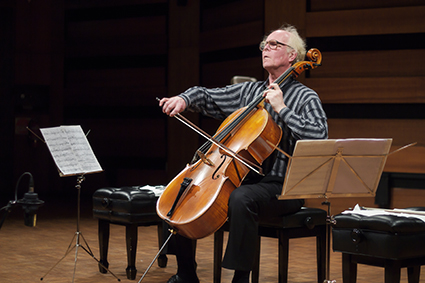The many-voiced cello of an Australo-German repertoire
Matthew Lorenzon: Totally Huge New Music Festival: Friedrich Gauwerky

Friedrich Gauwerky
photo Holly Jade
Friedrich Gauwerky
With his Amour–Soundbridge concert, cellist Friedrich Gauwerky ranged widely across the contemporary cello repertoire while exploring the musical ties between Australia and Germany. Gauwerky himself embodies these ties, having lectured in cello, chamber music and New Music at the Elder Conservatorium of Music in Adelaide in 1989–96. He also performed as principal cellist in the Australian ensemble Elision in1990–97.
Gauwerky’s artist’s note pointedly states that “[h]e is a free spirit who knows no national preferences and who feels equally at home in England, China, America and far-off Australia [haha] as he does in his home-town of Cologne.” The Amour–Soundbridge program is less an exploration of international ties than a positive statement of national boundlessness.
Msistlav Rostropovich commissioned Hans Werner Henze’s Capriccio as part of a dozen works for the 70th birthday of the Swiss cellist, conductor and impresario Paul Sacher in 1976. The piece, full of dramatic and structural conceits, including pitch material derived from the letters of Sacher’s name, depicts theatrical scenes, opening with guitar-like pizzicato chords under a sinuous melodic line. Gauwerky imbued the piece’s second movement with an incredible sense of urgency, the leaping melodic line interspersed with moments of double-stopped counterpoint.
The German-born composer Thomas Reiner studied under Henze before moving to Australia, where he now lectures at Monash University. Like Henze, he could not resist the cello’s lyrical capacity. His Three Sketches for solo cello begins with a singing movement utilizing the full register of the instrument. Reiner contrasts this lyrical movement with a grittier one utilizing double-stops and sul ponticello scrubbing. The third movement consists of pianissimo tremolo and light harmonics. These certainly are sketches of the most characteristic modes of the instrument. It would be interesting to explore how they are fleshed out in Reiner’s later chamber works.
If Henze and Reiner’s compositions inherit the cello’s romantic modes of expression, Klaus K Hübler’s opus breve pulls them apart through “action notation.” A kind of tablature separately indicates the bowing, fingering and string to be used on three staves. This form of notation is quite space-intensive, requiring three A3 pages for a piece only a minute and a half long. The benefit of “decoupling” bowing, fingering and string-use in this way is that one can notate complex gestures where each component of the sound moves independently. For instance, Hübler uses trills that are only partially sounded with the bow. Gauwerky emphasises the silent moments of these trills with percussive finger action, while the bow line utilises a range of effects including ricochets at the tip and intense scrubbing. Gauwerky somehow coordinates this ambidextrous explosion of energy.
In comparison with Hübler’s technical virtuousity, Karlheinz Stockhausen’s Amour is a heartfelt, naïvely beautiful outpouring of emotion. Originally written for clarinet and dedicated to one of the objects of Stockhausen’s affections, it was intended to be playable on any melodic instrument, but Stockhausen did not produce a version for cello during his lifetime. Gauwerky arranged it for cello in 2014 in cooperation with the publisher Stockhausen-Verlag. The piece sits so comfortably on the cello that it is hard to believe it was written for any other instrument.
Amour consists of three movements: “Cheer up,” “Your angel is watching over you” and “A little bird sings by your window.” The opening movement is comical, presenting a modal melody that occasionally explodes into angular chromaticism. The second movement alternates a low, lamenting voice with a higher, faster one. The two voices move closer together until they intermingle at the end. The birdsong of the final movement erupts with agile voices across the whole range of the instrument. Gauwerky gave the piece’s final, heartbreaking melody all of the space it needs, breathing deeply between each phrase.
Felix Werder escaped Nazi Germany in 1940 and settled in Melbourne, where he exerted an incredible influence upon Australian musical life until his death in 2012. His Violoncello Solo 1 is a whirlwind of distinct gestures, each beautifully crafted. The piece requires one to give in to the torrent of gesture and forego structural listening. Is this what Gauwerky meant when he said that there was “something very Australian in it”?
Volker Heyn’s Blues in B-flat is the bleakest work for cello I have ever heard. The composer moved to Australia from Germany in 1979. After studying at the Sydney Conservatorium, Heyn worked in a metal factory, the sounds of which Gauwerky likes to think still resonate throughout his music. The “Blues” of the work’s title is to be understood as a “cry of rebellion and despair.” The cello uses a scordatura, or retuning, of three strings in B-flat and one in F. Beginning with shocking sforzandi on two strings, the piece proceeds as a succession of drones including sung pitches, strings played past the cello bridge and drones played with two bows at once. Gauwerky seamlessly introduced and removed a mute from the bridge, smoothly changing the timbre of the drone.
After this incredible tour of Australo-German cello music, Gauwerky returned to where it all began: Paul Hindemith’s Sonata for Violoncello Solo. An encore of the cello solo from Stockhausen’s “Wednesday” from the opera Licht was an unexpected and welcome surprise. The Totally Huge New Music Festival has truly fostered a concert of “cultural significance,” giving Gauwerky the opportunity to share his unique long-term perspective on contemporary Australian and German music for the cello.






